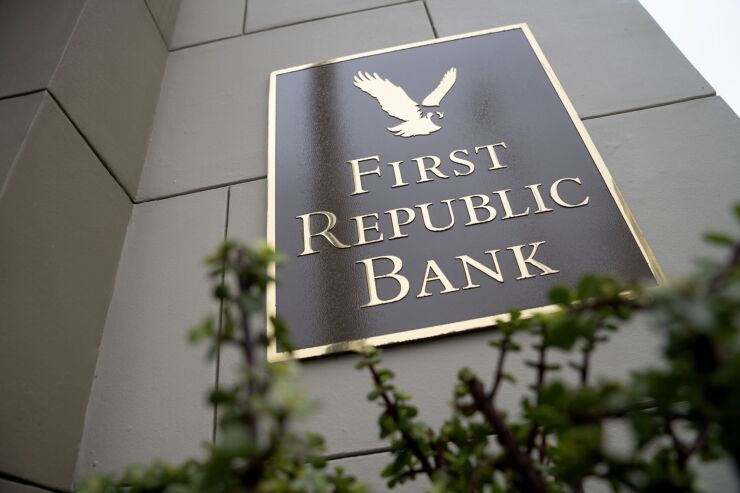
First Republic Bank said that it's slashing staff by as much as 25% and weighing "strategic options" weeks after its customers pulled $100 billion of deposits.
The San Francisco bank, which has teetered after the failures of Silicon Valley Bank and Signature Bank last month, reported its highly anticipated quarterly results on Monday. Observers who wanted substantial detail on the bank's condition were disappointed, since executives did not take questions from analysts.
The quarter was "worse than I thought," with deposit outflows coming in much higher than expected, said Tim Coffey, an analyst at Janney Montgomery Scott. Skipping the usual question-and-answer session with analysts is a sign that the bank "feels that it has few options left," he said.
"Their main focus right now is surviving, and nothing else matters," Coffey said.
First Republic's position is "worse than even bears had thought," Autonomous Research analyst David Smith wrote in a research note. The company's massive deposit outflows mean its profitability will be "squeezed tremendously," Smith said in an interview, since its borrowings have spiked and its expenses will rise substantially as it seeks to repay those funds.
"That speaks to just how challenging it's going to be for them to rebuild their way back out of this," Smith said.
If investors were looking for comfort, they might focus on the fact that the bank's deposit outflows stabilized at the end of March, and that First Republic is still around today. But the company's stock price was down 22.1% in after-hours trading after rising by more than 12% earlier Monday, before its earnings report was released.
First Republic was one of the regional banks that came under intense investor, depositor and media scrutiny after the bank failures last month. Big banks came to its rescue with a $30 billion
But the bank's deposits were still down by 40.8% at the end of March from $176.4 billion at the end of last year. When excluding the big banks' efforts, First Republic's deposits fell during the quarter by more than $100 billion.
Deposits have fallen slightly so far this quarter and stood at $102.7 billion as of April 21, down 1.7% from the end of March. The company said the decline primarily reflects "seasonal client tax payments that occur each April."
In brief remarks on Monday, First Republic President and CEO Mike Roffler thanked the big banks for their efforts, as well as federal and state regulators "who have continued to provide us with expert support."
The bank "experienced unprecedented deposit outflows," but deposits have been stable since the week of March 27, he said. Customers' average account sizes have dropped, but First Republic has "retained over 97% of client relationships that banked with us" at the start of the year.
"We are grateful for our clients who continue to place their trust in First Republic," Roffler said.
He also described the company's steps to slash expenses, including cutting about 20% to 25% of its workforce this quarter. The bank additionally said it's making "significant reductions" to executive pay, "condensing" its corporate office space and cutting non-essential projects. It also suspended its common dividend last month.
In addition, First Republic said it was "pursuing strategic options to expedite its progress while reinforcing its capital position." The bank did not provide additional details, and a spokesperson declined an interview request.
Coffey, the Janney analyst, said "everything's on the table." While selling the bank
For now, First Republic has addressed its deposit outflows by borrowing — an expensive option that Coffey said will drag down its future profitability.
The bank reported some $105.9 billion in short-term borrowings and long-term advances from the Federal Home Loan Bank system, up sharply from $14 billion at the end of last year. Borrowings peaked in mid-March at $138.1 billion, the bank said.
In order to pay for those borrowings, First Republic's interest expenses surged, rising from $97 million at the end of last year to $419 million last quarter.
Company executives are focused on increasing deposits from new consumers, small businesses and nonprofit organizations, Roffler said. They are also working with existing clients to inform them about how to get more of their deposits covered by the Federal Deposit Insurance Corp.
Uninsured deposits will be a "much smaller percentage of total deposits than in the past," Roffler said. Uninsured deposits made up 67% of First Republic's total deposits at the end of last year, a figure that has dropped to 27% when excluding the big banks' $30 billion in deposits.
The company has $45.1 billion of available borrowing capacity and cash on hand, which Roffler said is more than double its uninsured deposits when excluding the big banks' money.
The bank is also working on decreasing its loan balances. It's cutting back on loan growth and focusing on selling its loans in the secondary market, while retaining servicing responsibilities and remaining the "primary point of contact for our clients," Roffler said.
"Through these actions, we intend to reduce the size of our balance sheet, reduce our reliance on short-term borrowings and address the challenges we continue to face," he said.
The company's decision to shrink its balance sheet is "clearly the right call" given its deposit outflows, Autonomous Research's Smith said. But he also said the move is "very much out of character for what was one of the preeminent growth banks in the country for the last 40 years."






